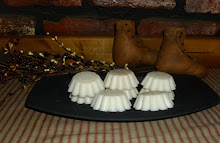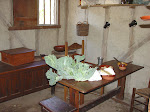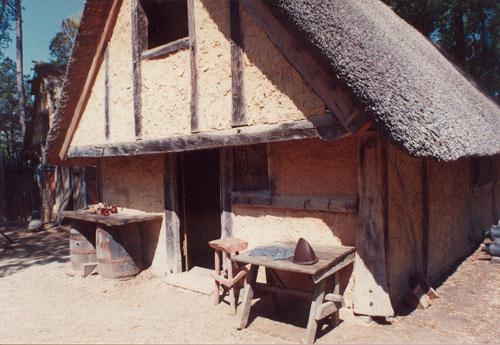I remember doing this as a child. My grandparents had a furnace that burned coal so it was ready available. You can also use a charcoal briquette or stones or small pieces of brick.
They are amazing to watch grow and young children are usually quite excited about them. Be sure to have adult supervision if children are making them as they do use amonia.
CRYSTAL GARDEN: 6 tablespoons salt, 6 tablespoons liquid bluing (see Note), 6 tablespoons water, 1 tablespoon ammonia, Food coloring (optional). Combine salt, bluing, water and ammonia. Pour over small pieces of rock or coal in a shallow glass or china bowl. Drip food coloring on top, if desired. Crystals will begin to grow soon. Add water occasionally to keep crystals growing. You'll probably want to place dish on a tray or wooden board as crystals grow over the sides of the bowl. Note: Liquid bluing can be found in most markets in with the laundry soaps and products. The most popular brand is Mrs. Stewart's Liquid Bluing and is used as a laundry whitener.
Welcome To Pilgrims and Pioneers!
After many years of researching my family geneaology I have been lucky enough to discover actual information about my relatives that lived in the Pilgrim Era and the Pioneer Era- while many people also have realtives from those eras- many do not know their names or where they lived- actually seeing the proof in print makes you much more aware of who they really were.
After discovering these relatives it of course made me curious to learn more about the eras that they lived in and what their lives were like as, the history I learned in grade school had long since been forgotten.
I decided to start this blog for others who are also interested in these eras.
Some of the information here will be actual facts about my realtives and some will be information about the eras in general that I have found on the web.
I hope you will enjoy traveling back in time with me!
After discovering these relatives it of course made me curious to learn more about the eras that they lived in and what their lives were like as, the history I learned in grade school had long since been forgotten.
I decided to start this blog for others who are also interested in these eras.
Some of the information here will be actual facts about my realtives and some will be information about the eras in general that I have found on the web.
I hope you will enjoy traveling back in time with me!
Saturday, June 28, 2008
Thursday, June 26, 2008
The Delta Queen


Built in 1926, gleaming with four decks of teak and original Tiffany-style stained-glass windows, Delta Queen accommodates just 176 guests, all in outside staterooms. Unique touches abound, including a rare ironwood floor gracing the Orleans Room, the heart of the ship's nightlife, and an 1897 steam calliope that was once salvaged from a sunken showboat and sold to a circus. You'll even find the very same ship's bell that sounded out landings for the steamboat Mark Twain rode downriver in 1883.
Come listen to the clang of that historic bell announcing your own shore landings. Dance on the floor Presidents Hoover, Truman, and Carter have graced. Grab a cup of coffee in the Forward Cabin Lounge and watch the sun burn off the mist over the Mississippi. Take your place in history, today. http://www.majesticamericaline.com/
Come listen to the clang of that historic bell announcing your own shore landings. Dance on the floor Presidents Hoover, Truman, and Carter have graced. Grab a cup of coffee in the Forward Cabin Lounge and watch the sun burn off the mist over the Mississippi. Take your place in history, today. http://www.majesticamericaline.com/
The Delta Queen has 80 crew members and a guest capacity of 176.
It has 88 state rooms and 5 public rooms.
The steam boat is 285 feet in length and 60 feet in width.
In 2000 while staying in Hannibal, Mo. I looked out my hotel window one morning and saw this magnificent river boat. Even though I was two blocks away I could tell this was a very large steam boat. I quickly dressed and walked the two blocks to get a better look. I was not disappointed- the steamboat was amazing! An elderly couple came along and asked if I would use their camera to take their picture in historic downtown Hannibal. Of course I did- and I also asked them about their cruise on this wonderful steamboat. They said they had left St.Paul, MN and would end their cruise in St. Louis, Mo. They said it was the most wonderful trip they had ever been on. I vowed to myself that day that I would too one day take the St.Paul? St. Louis cruise.
In 2000 while staying in Hannibal, Mo. I looked out my hotel window one morning and saw this magnificent river boat. Even though I was two blocks away I could tell this was a very large steam boat. I quickly dressed and walked the two blocks to get a better look. I was not disappointed- the steamboat was amazing! An elderly couple came along and asked if I would use their camera to take their picture in historic downtown Hannibal. Of course I did- and I also asked them about their cruise on this wonderful steamboat. They said they had left St.Paul, MN and would end their cruise in St. Louis, Mo. They said it was the most wonderful trip they had ever been on. I vowed to myself that day that I would too one day take the St.Paul? St. Louis cruise.
But alas that will not happen. This year is the last season for the magnificent Delta Queen.
There is a law that does not allow overnight cruises on wooden hulled boats. There have been several exemptions granted to the Delta Queen by Congress that has allowed the cruising to continue, this year that exemption was not granted. There have been several campaigns to try to save her but if my info is correct it has not happened- so good by Delta Queen and good by dream.
Wanting to see the inside of this boat I went to the website and found a picture of a stateroom- absolutely beautiful!
" The Mighty Mississippi"

As many of you have heard on the news or maybe know first hand the mighty Mississippi River has been a source of major flooding in the Midwest.
Today I traveled about 60 miles to Davenport, Ia having to cross the great Mississippi. I have done this many , many times and have boated on the Mississippi in Albany, Il. about 40 miles away from where I live.Today I realized that there may be many people that do not know much about this great river.
The Mississippi River is the 2nd largest river in North America being 2,350 miles long.
It starts as a small brook at Lake Itasca, Minnesota and ends where it empties into the Gulf of Mexico. The photo on the right shows the start of this great river.
The Missisisppi River basin was formed by glaciers, moving and melting millions of years ago, which left in their wake miles wide flood plains, that still fill up occasionally covering towns, roads, farms and anything else that might stand in the way of it's mighty waters.
The Ojibway Indians of northern Minnesota called it "Messipi" or "Big River".
There are records of human habitation along the Mississippi river dating back 5,000 years.
An average of 175 milloin tons of freight are shipped on the Upper Mississippi each year.
The famous Mark Twain even wrote a book about the Mighty Mississippi titled " Life on the Mississippi".
Today I traveled about 60 miles to Davenport, Ia having to cross the great Mississippi. I have done this many , many times and have boated on the Mississippi in Albany, Il. about 40 miles away from where I live.Today I realized that there may be many people that do not know much about this great river.
The Mississippi River is the 2nd largest river in North America being 2,350 miles long.
It starts as a small brook at Lake Itasca, Minnesota and ends where it empties into the Gulf of Mexico. The photo on the right shows the start of this great river.
The Missisisppi River basin was formed by glaciers, moving and melting millions of years ago, which left in their wake miles wide flood plains, that still fill up occasionally covering towns, roads, farms and anything else that might stand in the way of it's mighty waters.
The Ojibway Indians of northern Minnesota called it "Messipi" or "Big River".
There are records of human habitation along the Mississippi river dating back 5,000 years.
An average of 175 milloin tons of freight are shipped on the Upper Mississippi each year.
The famous Mark Twain even wrote a book about the Mighty Mississippi titled " Life on the Mississippi".
Saturday, June 21, 2008
1843- the Oregon Trail
The year 1843 marked the big exodus of pioneers making the trek westward.
It is said that approximately 1,000 people traveled this trail.
Here are some interesting tidbits from their journey:
The pioneers walked the Oregon Trail, but have you ever thought how many shoes were worn out by the time they reached Oregon?
According to the diary of May Ellen Murdock Compton, a 1853 emigrant, she started from Independence with ten brand new pairs of shoes and wore all of them out except the last pair. She saved this pair for the Oregon Country by walking barefoot over the last miles of her journey.
Pioneers had what they called a "Roadside Telegraph." Pioneers would write messages on anything that was available to communicate with other wagon trains. "Anything available" meant cloth scraps, animal skulls, rocks, bark, leaves, etc. Some places were "Prairie Post Offices" meaning there were a number of messages that had been left at that spot for others.
It took roughly $800-$1,000 to obtain a proper outfit (wagon, food, clothing, etc.) and enough supplies to live a whole year without planting or harvesting a crop. Some families saved for three to five years before being able to begin their trip west.
Toilet facilities were, for the most part, not mentioned in journals written along the Oregon Trail. But, according to emigrant Charlotte Pengra, one trail-side rest area looked more like a communal ditch. There are suggestions that the full skirts worn by most ladies acted as shields or "curtains of modesty" for this purpose. Obviously, bloomers would not provide this advantage.
It is said that approximately 1,000 people traveled this trail.
Here are some interesting tidbits from their journey:
The pioneers walked the Oregon Trail, but have you ever thought how many shoes were worn out by the time they reached Oregon?
According to the diary of May Ellen Murdock Compton, a 1853 emigrant, she started from Independence with ten brand new pairs of shoes and wore all of them out except the last pair. She saved this pair for the Oregon Country by walking barefoot over the last miles of her journey.
Pioneers had what they called a "Roadside Telegraph." Pioneers would write messages on anything that was available to communicate with other wagon trains. "Anything available" meant cloth scraps, animal skulls, rocks, bark, leaves, etc. Some places were "Prairie Post Offices" meaning there were a number of messages that had been left at that spot for others.
It took roughly $800-$1,000 to obtain a proper outfit (wagon, food, clothing, etc.) and enough supplies to live a whole year without planting or harvesting a crop. Some families saved for three to five years before being able to begin their trip west.
Toilet facilities were, for the most part, not mentioned in journals written along the Oregon Trail. But, according to emigrant Charlotte Pengra, one trail-side rest area looked more like a communal ditch. There are suggestions that the full skirts worn by most ladies acted as shields or "curtains of modesty" for this purpose. Obviously, bloomers would not provide this advantage.
Thursday, June 19, 2008
Save some money!

Since the price of everything has gone up- including my candle making supplies. I decided to do something nice for my customers.
For a limited time only I have created square mason sampler packs- 3 square mason jar candles for 19.50! With today's prices this is quite a deal and it won't last long so hurry!
To view go to the sale items page ( there are 2 pages) on my website.
Drying Apples
To prepare apples for drying- peel & core and cut into slices or rings. Any peelings left on will toughen during the drying process Pre treating is necesary toprevent the apples form turning brown.
To preserve dissolve one tablespoon of Ascorbic acid in one quart of cold water. Add cut fruit and soak cut apples for a few minutes. Remove the apples with a slotted spoon and let dry before dehydrating.
Oven drying is the fastest method of drying- set your oven on low- not over 140 degrees- prop the door open and place a fan so that it blows the moisture out of the way.
The fruit is dry when it is soft and pliable but shows no moisture when you cut into the dried fruit. To make sure fruit is dry place it an air thight container for several days. Check daily for condensation on the sides of the container- if it appears you need to dry the apples a little longer.
For best quality and nutrient content use with in 1 year.
To preserve dissolve one tablespoon of Ascorbic acid in one quart of cold water. Add cut fruit and soak cut apples for a few minutes. Remove the apples with a slotted spoon and let dry before dehydrating.
Oven drying is the fastest method of drying- set your oven on low- not over 140 degrees- prop the door open and place a fan so that it blows the moisture out of the way.
The fruit is dry when it is soft and pliable but shows no moisture when you cut into the dried fruit. To make sure fruit is dry place it an air thight container for several days. Check daily for condensation on the sides of the container- if it appears you need to dry the apples a little longer.
For best quality and nutrient content use with in 1 year.
A Sad story with a Happy Ending!
Last night while vending at our Farmer's Market we had the door open and I kept hearing a little "peeping" sound. I looked out the door and there was a baby Mallard duckling frantically running around the parking lot. Earlier in the day a mama duck and her babies had fallen into a sewer grate next to the market. A good samaritin had pulled off the cover and rescued the mama and her babies but appaprently this little one got left behind. I went out to get a better look at it and it promptly took off. I was so worried it was going to get hit by a car or starve to death I was heart broken.
But it was this little ducky's lucky day. My vending neighbor lives on a farm and has a Muscovie duck that has babies just a little older than this one. She went out into the parking lot and captured the baby duck- put it in a box and was taking it home to her mama duck to raise with her others.
Talk about being a lucky duck!
But it was this little ducky's lucky day. My vending neighbor lives on a farm and has a Muscovie duck that has babies just a little older than this one. She went out into the parking lot and captured the baby duck- put it in a box and was taking it home to her mama duck to raise with her others.
Talk about being a lucky duck!
Monday, June 16, 2008
Hennepin Feeder Canal- Opening Day 1907

In 1907 The Hennepin Canal (what many referred to as a wide ditch of worthless water) was connected to the Rock River as a means to haul grain and other items back and forth from the larger towns of Sterling and Rock Falls, Il to the smaller town of Tampico about 20 miles away.
This caused great ecxitement in all three towns!
Here is a picture thought to have been taken on the opening day. Note the Gibson Girl hairstyles and vintage clothing.
I am not sure of the date that the canal was closed- I know that my grandfather worked on this very canal in the 1920's -but it does not appear to have been as successful as they had planned on. My Mom's house is not far from the big gates that now keep the Rock River from flowing into the Hennepin Feeder canal.
Saturday, June 14, 2008
My How Times have Changed!!
My friend sent this link to me and I was amazed at how the price of things have gone up over the years! If you are curious too go take a look!
http://www.1970sflashback.com/1970/ECONOMY.asp
http://www.1970sflashback.com/1970/ECONOMY.asp
Friday, June 13, 2008
Homemade Laundry Soap
With everyone wanting and needing to be more frugal I thought I would post this recipe I found on another blog( Cathy- hazelruth's to be exacxt). I have not made any yet but she got several responses that said it works great.
You can cut the top off of an old detergent container or better yet put it in a big glass jar that has a lid.
Homemade Laundry Soap Recipe-16 cups water,1 bar of soap (your choice but many sources suggest Ivory, Fels-Naptha, Sunlight Bar, Castile or Zote)1 cup of baking soda or washing soda,1 1/2 cups borax.Before beginning, finely grate your bar of soap.Boil the 16 cups of water in a large pot. While boiling, add your grated soap and whisk continuously until it completely dissolves. Remove from heat.Next add borax and baking soda. Whisk it up really well. Continue to whisk throughout the day as it cools. It may begin to gel over the next 48 hours, but you don't need to wait to use it.You may store in old commercial detergent containers or any other covered container as well.Use ½ cup soap per load.You can also add 2 Tablespoons vinegar to the rinse cycle instead of fabric softener..I found all of the ingredients on the laundry aisle at my local grocery store.
You can cut the top off of an old detergent container or better yet put it in a big glass jar that has a lid.
Homemade Laundry Soap Recipe-16 cups water,1 bar of soap (your choice but many sources suggest Ivory, Fels-Naptha, Sunlight Bar, Castile or Zote)1 cup of baking soda or washing soda,1 1/2 cups borax.Before beginning, finely grate your bar of soap.Boil the 16 cups of water in a large pot. While boiling, add your grated soap and whisk continuously until it completely dissolves. Remove from heat.Next add borax and baking soda. Whisk it up really well. Continue to whisk throughout the day as it cools. It may begin to gel over the next 48 hours, but you don't need to wait to use it.You may store in old commercial detergent containers or any other covered container as well.Use ½ cup soap per load.You can also add 2 Tablespoons vinegar to the rinse cycle instead of fabric softener..I found all of the ingredients on the laundry aisle at my local grocery store.
Thursday, June 12, 2008
Bloggers! Save on our clean burning, pure soy candles!!!

Since Friday the 13th is noted for being an unlucky day- I have decided to make it a lucky day!
Buy one of our clean burning, highly scented, pure soy wax candles and get another one at 1/2 off.
Two square mason jar candles for 12.00! Don't miss this deal!!!
Just click on the "Specials" button and enter code BF13 on the order form.
Sale will end at Midnight on Friday the 13th.
Wednesday, June 11, 2008
The Food of Pioneers
Life on the Prairie was often a difficult one but these hard working breed learned to adapt and use what was available to them.
Game meat was very abundant as was pork but beef was not as readily available. Portions of beef were dried behind the stove or near the fire after it had been smoked and cured. It would become so dry and hard that it would have to be chipped off to use- thus the name of our modern day "chipped beef" gravy. The fat or tallow form the beef was saved and used for candle making.
Fruits & vegetables were seasonal. Crop produce could be stored in root cellars, dried or preserved with other methods.
Turnips, carrots,pumpkins, potatoes, nuts, and berries gave some variety to their diets but cornmeal was the mainstay.
Corn meal was made from whatever color corn was available- white, yellow, even red.
Corn meal mush was started cooking by the noon hour on the days that it was made,
Buckwheat was also used as it was a crop that could be planted late but be ready for harvest by winter. Buckwheat was used to make griddle cakes.
Game meat was very abundant as was pork but beef was not as readily available. Portions of beef were dried behind the stove or near the fire after it had been smoked and cured. It would become so dry and hard that it would have to be chipped off to use- thus the name of our modern day "chipped beef" gravy. The fat or tallow form the beef was saved and used for candle making.
Fruits & vegetables were seasonal. Crop produce could be stored in root cellars, dried or preserved with other methods.
Turnips, carrots,pumpkins, potatoes, nuts, and berries gave some variety to their diets but cornmeal was the mainstay.
Corn meal was made from whatever color corn was available- white, yellow, even red.
Corn meal mush was started cooking by the noon hour on the days that it was made,
Buckwheat was also used as it was a crop that could be planted late but be ready for harvest by winter. Buckwheat was used to make griddle cakes.
Monday, June 9, 2008
Feed Sacks, Flour Sacks- Frugal Fabrics



In the late 1800's feed sacks, flour sacks and, sugar sacks replaced barrels for packing feed and flour and sugar. Since our ancestors had to be frugal to survive the sacks were used to make many necessity items such as quilt blocks, aprons, house dresses and even underwear- for both men and women.
The fabric of these sacks were sometimes called "chicken linen" as chicken feed often came in this type of sack. The size of the sacks varied greatly from 5 lb bags to bags that were 5 or more feet long for picking cotton.
Many types of homemade solutions were used to try to remove the advertising labels from these sacks without much success- eventually most people stopped trying to remove the labels and used them as they were.
Feed sacks were still in limited use as late as the 1950's- today they are highly collectible.
Photos courtesy of Fabrics.net
Saturday, June 7, 2008
Beware! It's Poison Ivy Season!



Six years ago when we moved into my husband's parents house it was very overgrown outside- so I started chopping, pulling and, cutting down weeds. There were tons of vines I could not identify so I aked my husband what they were. He replied" oh those are wood vines, I pull them up every year. So I commenced to start pulling- a few days later I woke up to a whopping case of Poison Ivy- I had never had it before and was not sure which vines gave it to me. I had it so bad it took 6 weeks of prednisone therapy to get rid of it. Until a few days ago I had been very cautious- spraying outside with Roundup so I would not touch anything.
A few days ago I was walking by one of my flower beds and saw what appeared to be an Ivy vine crawling through my flowers- not thinking I reached down and pulled and pulled until I got it all out. Well a few days later I found out that I was correct- it was any Ivy vine- Poison Ivy! I now have poison ivy on several spots om my right hand- I decided to get on the web to see if I could find something that looked like what I had pulled up- and I did and sure enough it was poison ivy. I also found out that not all Poison Ivy does not looks alike so I am posting some pics for those of you who do not know what it looks like. I also found out that there is 3 leaves in a cluster on Poison Ivy plants- the way to remeber is- if it has three- let it be!
Thursday, June 5, 2008
About Early Log Cabins
I have been continuing to research what life was like for the Pioneers. Here are some facts you may not know.
In the loft or sleeping area in many cabins the rafters were used to dry vegetables and fruits from the Fall harvest. Imagine sleeping with squash and pumpkins hanging over your head!
In many cabins pelts from racoons and beaver hung from the ceiling- although I am sure this is not the original reason they were hung there- this added warmth to the cabin.
Since there was not any glass windows were made from paper that had been smeared with "Coon Grease" to let light into the cabin.
In the loft or sleeping area in many cabins the rafters were used to dry vegetables and fruits from the Fall harvest. Imagine sleeping with squash and pumpkins hanging over your head!
In many cabins pelts from racoons and beaver hung from the ceiling- although I am sure this is not the original reason they were hung there- this added warmth to the cabin.
Since there was not any glass windows were made from paper that had been smeared with "Coon Grease" to let light into the cabin.
Sunday, June 1, 2008
You Gotta See This Face!!
As most of you know I have a Basset Hound named Molly that I dearly love!
If you love Basset Hounds or any dogs for that matter you need to watch this video of Millie.
This little gal's face is sure to steal your heart!! I know she stole mine!http://www.youtube.com/watch?v=5Nl9JYEXqCU&NR=1
If you love Basset Hounds or any dogs for that matter you need to watch this video of Millie.
This little gal's face is sure to steal your heart!! I know she stole mine!http://www.youtube.com/watch?v=5Nl9JYEXqCU&NR=1
Subscribe to:
Posts (Atom)
Prairie Wild Morning Glory

Prairie Phlox

Prairie Sundrops

The Famous Rock!
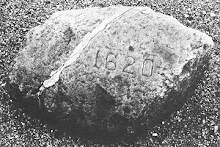
Plymouth Rock dated 1620
Plimoth Plantation
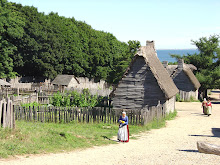
The Village
Plimoth Plantation

A Keeping Room






